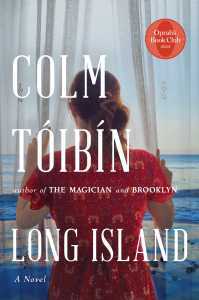Long Island, by Colm Toibin

Over fifteen years ago when I read Colm Toibin’s novel Brooklyn, I was quite distracted by the fact that my own novel about immigrants coming to Brooklyn was being released that same year. I did manage to get past that enough to read Toibin’s novel and appreciate what a beautifully written, evocative book it was; my main critique of it (which was not really a critique, because it was absolutely intentional on Toibin’s part, just annoyed me) was the passivity of the main character, Eilis Lacey, the young woman who moves from a small town in Ireland to Brooklyn, New York in the 1950s.
This novel picks up twenty years later. Eilis is married to her Italian-American husband and they no longer live in New York; consistent with the fortunes of upwardly mobile (not to say “white flight”-ing) Brooklynites by the 1970s, the whole extended family has now moved to Long Island, where they live in four houses next to each other on a cul-de-sac and experience a little more family togetherness than Eilis, who has never really felt part of the clan, is comfortable with.
Eilis’s children are in their late teens, almost ready to launch into independence, and with her home, her marriage, and her job as bookkeeper for a neighbour’s small business, she seems to be in a manageable if not thrilling routine. Then she learns something that shakes her marriage, and by extension her whole Long Island life, to its foundations.
I appreciated seeing that on receiving this news, Eilis shows she is a much less passive woman than she was in Brooklyn (or in Brooklyn, I guess). Her response to the crisis is very firm and very decisive, and never wavers. On the heels of this upheaval, she packs up and returns on an extended visit to her aging mother in Ireland, inviting her teenage children (but definitely not her husband) to join her later in the summer for their grandmother’s eightieth birthday party.
The novel is told from three points of view: Eilis herself; Jim Farrell, the man she was seeing back in Ireland before she got married; and Nancy Sheridan, who was Eilis’s best friend back home with whom she’s lost touch. As events both in Ireland and back in Brooklyn move towards inevitable conflict, my sympathies shifted among the characters and my perception of them as people changed quite a bit. The story ends very abruptly — whether because there is going to be a third Eilis Lacey book, or because we are left to draw our own conclusions about how things get resolved … well, that remains to be seen, I guess.



